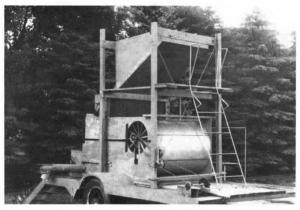He Uses Air Power To Clean Grain
 ✖  |
Last summer Heinz Henricksen, Bienfait, Sask., had a lot of weed-infested grain that had to be cleaned before it went into storage. He got the job done fast - at a rate of 600 bu. per hour - using his home-built "air flow" grain cleaner.
"It removes nearly all the weed seeds from my grain yet I built it for less than $300," says Henricksen, who says his grain cleaner compares favorably with the best commercial units on the market.
The trailer-mounted cleaner uses air instead of screens to clean grain. It consists of two large home-built fans housed inside a large metal drum. Freshly harvested grain is augered into a slant-bottom hopper on top (salvaged from an old combine). It feeds grain into a hopper just below it. A belt-driven square steel shaft mounts at the bottom point of the lower hopper. As it rotates, it allows a thin "sheet" of grain to fall straight down. Lighter material such as weed seeds, chaff, and dust is blown out onto the ground at the end of the trailer while heavier, clean grain falls into another hopper where it's augered out into a bin.
"I use it during harvest whenever we have a dirty crop like we did last summer. It handles up to 600 bu. per hour. I got the idea from a Manitoba farmer who had built a small wooden one.
"Both fans are shaft-driven by a hydraulic motor that's powered by a tractor's remote outlets. I use the tractor throttle to adjust fan speed.
"I stand on a platform next to the hop-per as it's being filled so I can get the cleaner adjusted properly and shut it down if anything goes wrong. The bottom hopper that catches clean grain moves back and forth so you can adjust it depending on what kind of trash you're trying to blow out of the grain. The hop-per is mounted on rollers and is moved by turning a steering wheel."
Each fan has 10 blades. Henricksen used flat steel to make the blades, curving them slightly to catch more air, then welded them onto a shaft. "The fans are separated by a plywood divider so they don't `fight' each other, causing reduced velocity," notes Henricksen.
Contact: FARM SHOW Followup, Heinz Henricksen, Box 123, Bienfait, Sask., Canada S0C 0M0 (ph 306 388-2645).

Click here to download page story appeared in.
Click here to read entire issue
He Uses Air Power To Clean Grain GRAIN CLEANERS Grain Cleaners (29C) 18-6-10 Last summer Heinz Henricksen, Bienfait, Sask., had a lot of weed-infested grain that had to be cleaned before it went into storage. He got the job done fast - at a rate of 600 bu. per hour - using his home-built "air flow" grain cleaner.
"It removes nearly all the weed seeds from my grain yet I built it for less than $300," says Henricksen, who says his grain cleaner compares favorably with the best commercial units on the market.
The trailer-mounted cleaner uses air instead of screens to clean grain. It consists of two large home-built fans housed inside a large metal drum. Freshly harvested grain is augered into a slant-bottom hopper on top (salvaged from an old combine). It feeds grain into a hopper just below it. A belt-driven square steel shaft mounts at the bottom point of the lower hopper. As it rotates, it allows a thin "sheet" of grain to fall straight down. Lighter material such as weed seeds, chaff, and dust is blown out onto the ground at the end of the trailer while heavier, clean grain falls into another hopper where it's augered out into a bin.
"I use it during harvest whenever we have a dirty crop like we did last summer. It handles up to 600 bu. per hour. I got the idea from a Manitoba farmer who had built a small wooden one.
"Both fans are shaft-driven by a hydraulic motor that's powered by a tractor's remote outlets. I use the tractor throttle to adjust fan speed.
"I stand on a platform next to the hop-per as it's being filled so I can get the cleaner adjusted properly and shut it down if anything goes wrong. The bottom hopper that catches clean grain moves back and forth so you can adjust it depending on what kind of trash you're trying to blow out of the grain. The hop-per is mounted on rollers and is moved by turning a steering wheel."
Each fan has 10 blades. Henricksen used flat steel to make the blades, curving them slightly to catch more air, then welded them onto a shaft. "The fans are separated by a plywood divider so they don't `fight' each other, causing reduced velocity," notes Henricksen.
Contact: FARM SHOW Followup, Heinz Henricksen, Box 123, Bienfait, Sask., Canada SOC OMO (ph 306 388-2645).
To read the rest of this story, download this issue below or click
here to register with your account number.







